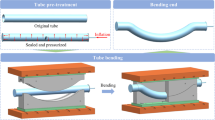Abstract
Bending of a thin-walled tube with small relative bending radius is a hot topic which has aroused extensive attention in recent years. The main disadvantage of tube parts with small bending radius fabricated by available bending approaches is non-uniform wall thickness, large springback, poor fatigue performance, and wrinkle that is difficult to control for thin-walled tube bending. In order to solve this problem, a Bend-Bulge Forming (BBF) process combining rotary draw bending and hydroforming that realizes the fabricating of thin-walled elbows with small bending radius has been put forward in this study, and both FEM simulations and experiments were carried out. Meanwhile, in order to reveal the deformation behavior and the failure during BBF process, theoretical and FEM analysis were conducted by free expansion with bent tubes. The results show that the axial feeds play a prominent role in the hydroforming process. It can promote the tube wall outside of the bend contact with hydroforming die and avoid the excessive thinning. At the same time, the tube wall inside of the bend which is thickened during bending operation can be deformed sufficiently. Finally, the final parts fabricated by the BBF process have approximately constant wall thickness and high precision.
Similar content being viewed by others
Reference
Zeng YS, Li ZQ (2002) Experimental research on the tube push-bending process. J Mater Process Technol 122:237–240
Kami A, Dariani BM (2011) Prediction of wrinkling in thin-walled tube push-bending process using artificial neural network and finite element method. Proc IMechE Part B: J Engineering Manufacture 255:1801–1812
Montazeri S, Gorji A, Bakhshi M (2016) A new method for compression bending of thin walled tubes in hydro-bending process. J Adv Manuf Technol 85:557–571
Xie WC, Teng BG, Yuan SJ (2015) Deformation analysis of hydro-bending of bi-layered metal tubes. J Adv Manuf Technol 79:211–219
Ahmetoglu M, Atlan T (2000) Tube hydroforming: state-of-the-art and future trends. J Mater Process Technol 98:25–33
Keeler SP, Backofen WA (1963) Plastic instability and fracture in sheets stretched over rigid punches. ASM Trans 56:25–48
Goodwin GM (1968) Application of strain analysis to sheet metal forming in the press shop. SAE Technical Paper No. 680093
Kim SW, Song WJ, Kang BS, Kim J (2005) Analytical and number approach to prediction of forming limit in tube hydroforming. Int J Mech Sci 47:1023–1037
Hwang YM, Lin YK, Chuang HC (2009) Forming limit diagrams of tubular materials by bulge test. J Mater Process Technol 209:5024–5034
Chen XF, Li SH, Yu ZQ, Lin ZQ (2012) Study on experimental approaches of forming limit curve for tube hydroforming. Int J Adv Manuf Technol 61:87–100
Chen XF, Yu ZQ, Hou B, Li SH, Lin ZQ (2011) A theoretical and experimental study on forming limit diagram for a seamed tube hydroforming. J Mater Process Technol 211:2012–2021
Graf A, Hosford W (1993) Calculations of forming limit diagrams for changing strain paths. Metall Trans A 24:2503–2512
Kleemola HJ, Pelkkikangas MT (1977) Effect of predeformation and strain path on the forming limits of steel copper and brass. Sheet Met Ind 63:591–599
Stoughton TB (1999) A general forming limit criterion for sheet metal forming. Int J Mech Sci 42:1–27
Yoshida K, Kuwabara T (2007) Effect of strain hardening behavior on forming limit stresses of steel tube subjected to nonproportional loading paths. Int J Plasticity 23:1260–1284
Nurcheshmeh M, Green DE (2011) Investigation on the strain-path dependency of stress-based forming limit curves. Int J Mater forming 4:25–37
Ge YL, Li X, Lang LH, Ruan SW (2016) Optimized design of tube hydroforming loading path using multi-objective differential evolution. In J Adv Manuf Technol DOI. doi:10.1007/s00170-016-8790-2
Singh H (2000) Computer simulation of tubular hydroforming. Tube Pipe J 11:8–13
Stange RR (1997) Tooling and methods for tube and pipe bending: the importance of proper equipment and proven techniques. Tube Pipe J 11:28–35
Wierzbicki T, Bao YB, Lee YW, Bai YL (2005) Calibration and evaluation of seven fracture models. Int J Mech Sci 47:719–743
Lei LP, Kim J, Kang BS (2000) Analysis and design of hydroforming process for automobile rear axle housing by FEM. Int J Math Tools Manuf 40:1691–1708
Kim KJ, Kim K, Kang Y, Park JH (2013) Conical tube hydro-forming design of automotive instrument panel beams using computer aided engineering. Mat-wissuWerkstofftech 44:354–359
Author information
Authors and Affiliations
Corresponding author
Ethics declarations
Conflict of interest
The authors declare that they have no competing interests.
Rights and permissions
About this article
Cite this article
Kong, D., Lang, L., Ruan, S. et al. A novel hydroforming approach in manufacturing thin-walled elbow parts with small bending radius. Int J Adv Manuf Technol 90, 1579–1591 (2017). https://doi.org/10.1007/s00170-016-9492-5
Received:
Accepted:
Published:
Issue Date:
DOI: https://doi.org/10.1007/s00170-016-9492-5



